Chicken Breeds – The Ultimate Beginners Guide
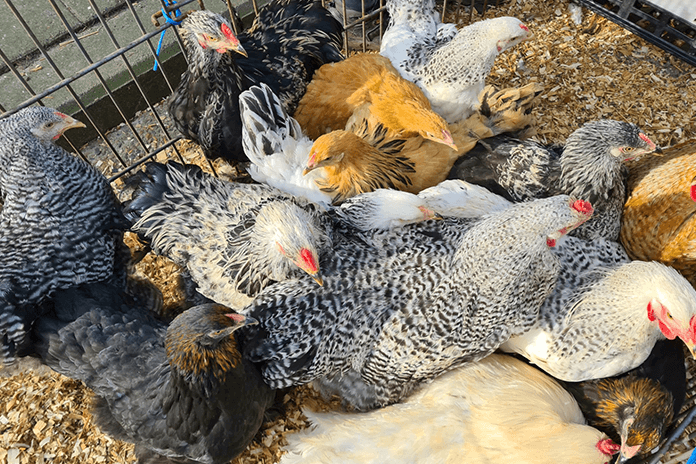
First of all, there are hundreds of chicken breeds! If you want to get to know them all, rare and common, go to our ‘All Chicken Breeds & Types Worldwide: List of 500+ Breeds‘.
But if you’re looking for the perfect breed to keep in your backyard, you’ve come to the right place. How do you know what breed to go for?
We’ll guide you.
What Types of Chicken Breeds are there?
Well, there are several ways to categorize breeds.
Ask yourself: why do you want to get chickens?
- eggs vs. meat: some breeds are egg-laying machines, others provide meat for the kitchen, and hybrid breeds are the best of both worlds
- pets: child-friendly breeds that are affectionate
- size: some breeds have miniature versions, also known as Bantams, ideal for small backyards. While others are known for their giant size
- looks: some breeds are show lines, ideal pet chickens to showcase and go viral on Instagram
So, there is something to think about!
Without further ado, let’s compare some of the most common breeds.
Common Beginner-Friendly Chicken Breeds
The following list is an overview of 15 very common beginner-friendly chicken breeds.
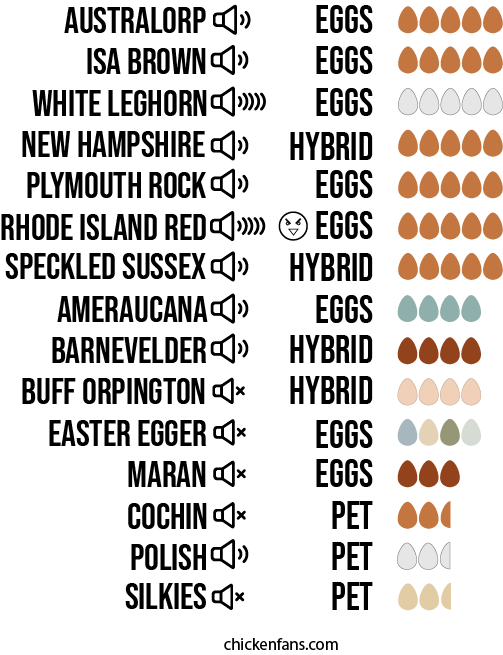
As you can see, some breeds, like the Australorp and White Leghorn, are real egg machines. They produce 5 to 6 eggs per week!
Other breeds like the Ameraucana and the Easter Egger are kept for their beautiful colored eggs.
And yet some others, like Silkies, are kept for their astonishing looks and as pet chickens. Some people even keep them in-house, walking around with diapers. They are only laying two or three eggs a week.
With our chicken coop and run size calculator, you can calculate the amount of space you need in the chicken coop and chicken run.
Let’s take a closer look at each of these groups, so you can choose the right birds for your flock.
The Egg Layers
If you like to have your weekly eggs, take a look at some of the best egg layers on the planet.
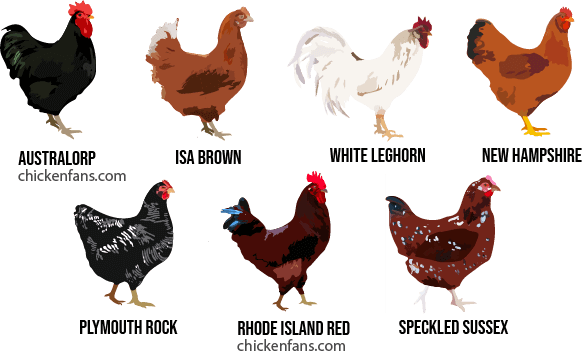
Most of them produce brown-colored eggs, but the Leghorn makes large white eggs almost daily. People in Europe and the UK usually prefer brown eggs, whereas white is the more popular choice in the US.
The Brown Leghorn, White Leghorn, and the famous Rhode Island Red are slightly noisy compared to the others on the list. But they’re still quite suitable as a backyard pet, even in a suburban neighborhood.
Let’s go through this list to give you an idea of what kind of chickens we’re dealing with.
Australorp
The Australorp is a very popular breed since it’s extremely low maintenance, produces 5 eggs per week, and is very child-friendly.
Australorps are originally Australian Orpingtons and they broke some egg-laying world records in the past.
They won’t fly too high, so they can be kept with lower fencing. They are available in black, blue and white, although white isn’t that common.
Australorps are medium to large-sized and can be a bit heavy to lift up. The Australorp is also available in Bantam size.
They are friendly and docile and will follow you through the garden.
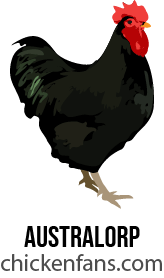
ISA Brown
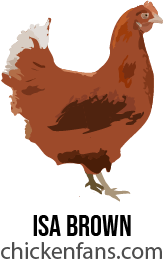
The ISA Brown breed was created for the poultry industry and will produce 5 to 6 large brown eggs per week. The name ISA Brown is a copyrighted brand: ISA stands for Institut de Sélection Animale (France). The ISA Brown is not a pure breed but is a sex-linked crossbreed.
They are very friendly and docile medium-sized chickens. They are great with children and like to cuddle.
They have an upward tail, are pretty hardy, and adapt to any climate.
Because they like humans so much, the ISA Brown is a very popular breed for backyard chickens.
White Leghorn
The White Leghorn is the variety of the Leghorn breed that is the most productive egg layer. They produce four to six white eggs every week with minimal feed.
In contrast to the previous breeds, the leghorn is certainly not a lap chicken. They are pretty noisy, nervous, and flighty. They are, however, beginner-friendly.
They are pretty hardy, but they prefer a warmer climate.
Because the White Leghorn is such a prolific white egg layer, it’s also one of the most abused chicken breeds. You can give them a second life in your backyard if you want. If you prefer some color in your flock, you can also opt for the Brown Leghorn.
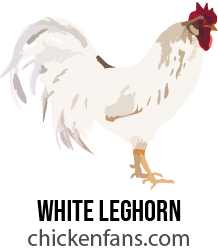
New Hampshire
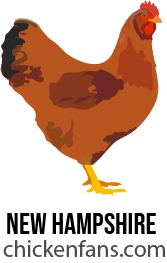
The New Hampshire breed is a modern dual-purpose hybrid breed. They produce more than 250 brown eggs per year. The hens can be pretty broody and make good mothers.
They are very friendly and tame, but they can be a bit pushy with food when they are in a flock with other breeds. The hens are great as pet chickens in your backyard. There is also a Bantam version available.
They are cold hardy, but in hot temperatures, they will need some shade. Furthermore, they are very robust and easy to manage.
Plymouth Rock
Plymouth Rock is a very popular breed that exists since the 1800s. The hens will lay around four to five light brown eggs every week. They will also produce eggs during the wintertime.
The hens are very friendly and docile and go well with kids. They are pretty large and weigh 7 to 10lbs, but are also available in Bantam sizes and multiple color varieties. The most well-known is the Barred Plymouth Rock.
They have a colored spot on their head that immediately reveals whether they are pullets or cockerels, right after hatching.
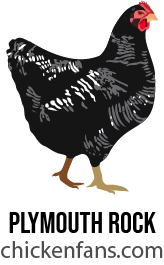
Rhode Island Red
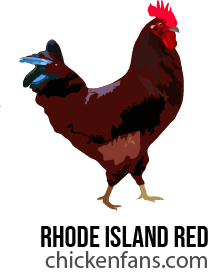
The Rhode Island Red is one of the most popular breeds in the world.
The hens are prolific egg layers and will produce more than 250 light brown eggs per year. Sometimes the Rhode Island Red is also referred to as a dual-purpose hybrid bread, but usually, they are kept for their egg-laying capabilities.
They are pretty loud and assertive, and the roosters can get quite aggressive. They won’t blend in well in an urban environment. This behavior is mostly towards other chickens, who are very friendly towards humans.
They are very beginner-friendly and perfect for inexperienced breeders, as they can survive in pretty dubious conditions.
Speckled Sussex
Speckled Sussex chickens are graceful camouflaged chickens with silver speckles and a red shine. They were already laying eggs in the Roman era.
The hens will produce four to five light brown eggs per week. They
The hens are very calm, lovely, child-friendly, and will follow you in the backyard. They also work well with other breeds. They are pretty large, but you can also find Bantam-sized varieties.
Sussex chickens are hardy, although they don’t like the heat too much. They are very well suited for beginners.
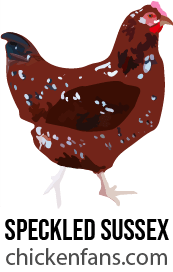
The Colored Egg Layer Breeds
Some breeds are popular due to their attractive colored eggs.
For example, the Ameraucana is a breed that is famous for its blue eggs. The hens are genetically modified and carry the blue egg gene. Ameraucanas were originally bred from Araucanas. The Ameraucana is probably an ancestor of the Easter Egger!
Easter Egger
With the Easter Egger, you never know what the color of the eggs will be before they start laying. The egg color that they produce is embedded in their DNA: they will always produce the same color as eggs.
The color of the eggs can be anything from blue and olive to pink or pale yellow. The color of the eggs is usually the darkest when they start laying in springtime.

Easter Eggers don’t have a typical appearance and can look very different depending on the chicken. They usually take the look of their parents.
The Instagram Chicken Breeds
Some breeds just won the genetic lottery.
The Cochin Chicken, Polish Chicken, and Silkies are very popular breeds because they have such incredible looks.
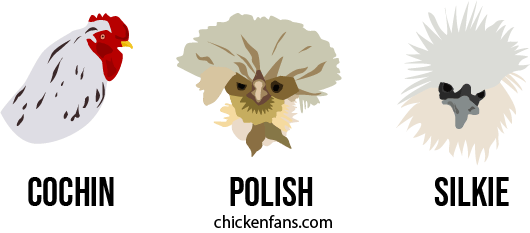
Some people like to crossbreed them with chickens having a gene that makes their feathers curl upward. That’s what we call a Frizzle chicken. Frizzle chickens can be any breed, Silkies, Cochins, Polish or other breeds, but they all have the distinctive characteristic of curly feathering.
Cochin Chickens
The Cochin is a large chicken breed that is covered in fluffy feathers from top to toe. The chickens were originally imported from Shangai by Queen Victoria and caused a real chicken craze, also known as the Hen Fever.
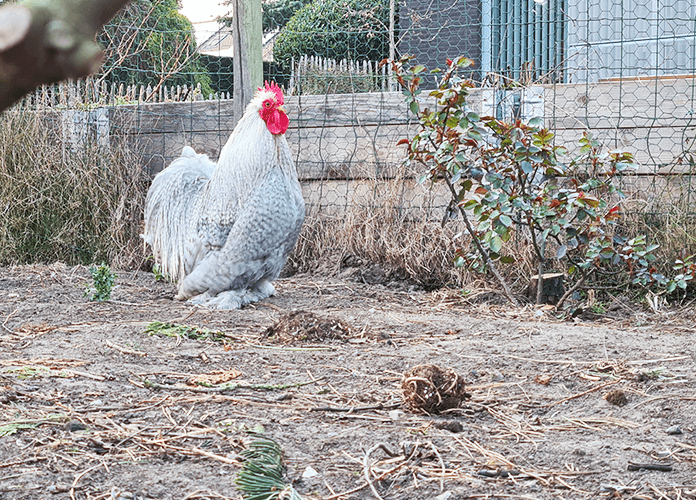
They are very calm and friendly lap chickens that are ideal for children. Cochin chickens are pretty large, but there are also Bantam varieties available.
This breed isn’t terrific egg-layers, giving only about 180 small brown eggs yearly. However, unlike the other species, they prefer to lay eggs during the winter, which can come in handy!
Polish Chickens
Polish Chickens are eccentric in their appearance. The females look like they just came from the hairdresser’s, with their hair up. The males look like they haven’t combed their hair in five days. Because of their hairdo, they can have limited eyesight.
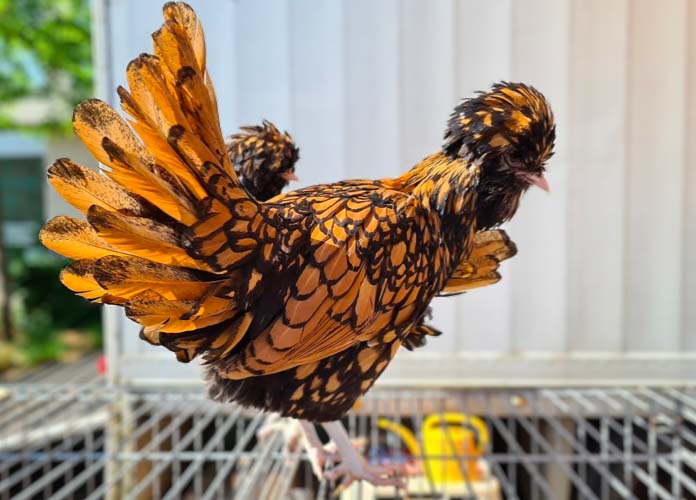
They lay about two to three eggs per week.
The hens are very friendly, tender, and quiet, and ideal with children to cuddle.
Silkies
The Silkie is yet another Chinese breed that has become very popular worldwide. Silkies look like they have fur instead of feathers, giving them a distinguishable look. The fluffy plumage comes in various color hues, including black, white, blue, and gold.

They only lay about two or three eggs per week, but they can be very broody. They are used a lot as brooders for egg hatching.
Silkies are very friendly and ideal for kids to cuddle and take on their lap. They are not too difficult to keep, but they need vaccination for Marek’s disease, and sometimes they forget to eat when they are too broody.
Other Chicken Breeds
Although we’ve come to a long end, hundreds of other breeds still haven’t been discussed. However, with the information above, you will come a long way.
If you want to check out all the breeds we address, go to our ‘Breeds Page’, our listed article page ‘The Classroom‘, or check out this comprehensive list:
- The Rhode Island Red chickens, a popular egg-laying breed in the US
- The big Brahma chickens imported from the Far East and responsible for the Hen Fever
- The Plymouth Rock chicken, a dual-purpose breed well-known for its barred variant
- The Orpington, a large dual-purpose chicken breed that’s gentle and kind, with the Lavender version as an upcoming variety
- The Wyandotte, a dual-purpose breed with beautiful colors
- The Brown Leghorn as an alternative to the White Leghorn, an excellent egg layer
- The Dutch Bantam chickens are favorites of many show breeders
- The 55 Flowery Breeds by Silverudd, rare auto-sexing chicken breeds from Sweden
- The Vorwerk chickens, a German breed with a beautiful black-on-gold pattern
- The Marans, a French breed of chickens that lay beautiful dark brown eggs
- The Sapphire Gem, a beautiful Plymouth Rock cross
- The Cinnamon Queen, an amazingly hardy bird that’s a great egg layer
- The Calico Princess, a fairly new breed that’s a real egg-machine
- The Faverolles, a French breed that’s quite large with a very fluffy look
- The Malines, a heavy meat bird, that also lays a decent amount of eggs
- The White Faced Black Spanish, an ancient heritage breed with distinguished looks
- The Mystic Onyx, a black breed with a name as amazing as its looks
- The Green Queen, a breed that lays amazingly green-colored eggs
- The Swedish Flower Hen, a traditional ultra-rare Swedish breed with extraordinary looks
- The Araucana, a blue-egg-layer
- The Silkie, the fluffiest backyard pet that’s great for children
- The Deathlayer, a chicken as hardcore as its name
- The Polish, all about this fluffy and funny-looking breed
- The Sussex chicken, a British dual-purpose breed
- The Frizzle chicken, a great backyard pet that’s beginner friendly and Instagram-worthy
- The Isbar Chicken (Silverudd Blå): A Swedish beauty
- The Hedemora Chicken, the hardiest chicken breed in the world
- The Australorp: All about this gentle breed
- The Prairie Bluebell Egger, a fairly new hybrid breed that lays blue eggs
- The Jersey Giant, one of the largest chicken breeds in the world
- The Cochin, a Chinese beauty
- The Sagitta, a mixed dual-purpose breed
- The Ayam Cemani, the black beauty of chickens
- The Pavlovskaya, a beautiful ultra-rare Russian breed
- The Pita Pinta Asturia, a rare chicken breed
- The Hampbar, a Canadian dual-purpose breed
- The Smokey Pearl, a new hybrid chicken
- The Lakenvelder, a great-looking black and white chicken of German and Dutch descent
- The Golden Comet, a hybrid red sex-link chicken
- The ISA Brown, a famous brown laying hen
- The Belgian D’Uccle Bantam, a fluffy and sweet true bantam breed
- The Malay, a majestic giant
- The Cream Legbar, a pastel-colored egg layer
Each breed has its traits and characteristics. Be aware that some varieties are difficult to maintain or are very sensitive to diseases. Depending on the region, you will also find very local varieties. These varieties do not always thrive in every climate.
Most backyard chickens aren’t pure breeds; they are crossbreeds. Through breeding, the genetic pool becomes mixed, creating wide varieties. As long as you don’t participate in poultry shows, it doesn’t matter what kind of comb your Plymouth Rock carries. You can even start breeding chickens and experiment with the genes in your own flock.
When choosing a breed, always check whether you have enough space to house it. You can always opt for the Bantam version if you have limited space. Use our ‘Coop Size Calculator‘ to ensure you’ve provided plenty of space.
Have fun selecting your chicken breed!






















